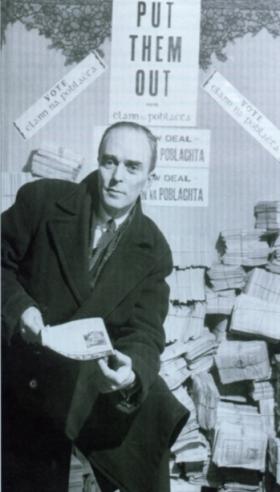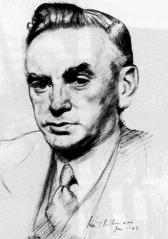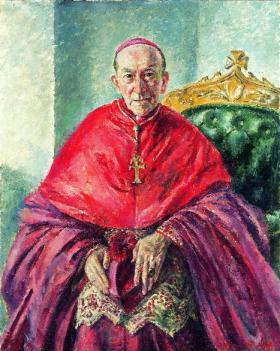The first coalition—60 years on
Published in 20th-century / Contemporary History, Issue 1 (Jan/Feb 2008), News, Volume 16
‘Put them out!’—Clann na Poblachta leader Seán MacBride during the election. For a time it looked as if the party would sweep the country, but in the event they only won ten seats. (Getty Images/Time Life Pictures)
In February 1948 Éamonn de Valera and his party lost power after sixteen years in government. A few years earlier he had looked unassailable, and was admired for his calmness and statesmanship during the Emergency. Now the opposition parties rallied behind the slogan ‘Put them out!’, and the electorate did their bidding. The ensuing excitement was caught by Fine Gael minister Patrick Lindsay in his memoirs. He parked his car, he said, diagonally in Tuam, Co. Galway, in order to enquire whether there was news from Dublin. A guard informed him: ‘At ten past five this afternoon, Mr John A. Costello was elected Taoiseach’. Lindsay, ecstatic, invited the guard for a drink. ‘We’ll have two’, came the reply, ‘for we have freedom for the first time in sixteen years.’
Fianna Fáil had ruled since 1932, and de Valera had competently steered the country through the difficult years of World War II. One of his preoccupations was keeping the IRA in check. This he did with firmness, and even ruthlessness. He interned many of them and, using military tribunals, executed some. When the war ended, a large number were released and a new political party, Clann na Poblachta, was launched. Its founder was Seán MacBride, son of the 1916 patriot Major John MacBride and the firebrand Maud Gonne, whose beauty had enslaved W. B. Yeats years before. In the ’30s Seán MacBride had been one of the leaders of the IRA. He later became a barrister, and during the war defended many IRA men who were put on trial. It was not surprising, therefore, that a number of ex-internees should join his party in 1946. The following year Clann na Poblachta won two out of three by-elections, one by MacBride himself.
For a time it looked as if Clann na Poblachta would sweep the country. In an effort to arrest its growth, de Valera called a snap election in February 1948. It was a cold, blustery month and the stakes were high. MacBride and his mixture of ex-internees, enthusiastic newcomers and bandwagon-hoppers campaigned with vigour. But it was not as easy to dislodge the old loyalties to Fianna Fáil as some had thought, and only ten of Clann na Poblachta’s 93 candidates were elected. This was, however, sufficient to deny de Valera an overall majority. Fine Gael won 31 seats, Labour fourteen, Clann na Talmhan seven and National Labour five. These parties, with Clann na Poblachta and a handful of independents, saw to it that Dev and his colleagues went into opposition.
It was Clann na Poblachta that provided the new government with policies and ideas. It also provided two spark-plug ministers: MacBride, who became minister for external affairs, and Dr Noel Browne, who took up the health portfolio. Brown was then only 32 and, unlike his fellow Clann TDs, came from a non-political background. Tuberculosis (TB) had robbed him of both his parents, a sister and a brother, and he himself had been hospitalised. He was determined to eradicate the disease that then scourged the country.
While Brown concentrated on health matters, MacBride took a leading role in government and succeeded in having many of Clann na Poblachta’s policies adopted. Foremost was the repeal of the External Relations Act. It should be remembered that until this time the Irish state was part of the British Commonwealth, and Britain claimed the right to accredit its diplomatic and consular representatives. For MacBride this had to end, if full sovereignty was to be achieved. Shortly after the formation of the government, the Dáil passed the Republic of Ireland Act. The British government reacted angrily and enacted its own Ireland Act, which affirmed that Northern Ireland would not cease to be part of the United Kingdom ‘without the consent of the parliament of Northern Ireland’.
While MacBride was making headlines, Dr Brown was carrying out a revolution in the health service. Within a few years he had practically eradicated TB, the greatest pestilence since the Famine. He had persuaded the cabinet to sanction huge sums (for those times) towards health care. In 1947 the public health budget was £617,905. In Brown’s first year more than £2 million was spent, and by 1951 he was spending £5 million per annum. But it was not only TB that he challenged; he also targeted backwardness in the Department of Health, outdated practices in numerous hospitals and even attitudes in the medical profession itself. The high walls around mental hospitals were lowered and the poor souls within were given better treatment and hope. County hospitals, many of which could not be relied upon to successfully carry out an appendix operation, suddenly had modern theatres and highly qualified staff. Brown worked night and day, and imbued his civil servants with such enthusiasm that many started coming in early and working late. It was a crusade, and the Irish people were the beneficiaries of a remarkable metamorphosis.

Fine Gael’s John A. Costello was elected taoiseach. (Fine Gael Press Office)
The Labour Party leader, William Norton, was tánaiste and minister for social welfare. He too achieved much. The old age pension had stood at ten shillings a week for decades. There had been appeals for an extra shilling or two in the 1946 and 1947 budgets, but to no avail. Norton increased the rate by five shillings (50%) in his first year. The sums involved seem ridiculous today, but they represented real money 60 years ago. The tánaiste also proportionately increased pensions for widows, orphans and the blind. Furthermore, the means test (by which entitlements were assessed) was modified.
Labour’s Tadg Murphy was minister for local government and pursued a progressive housing policy. In 1947 only 1,460 houses were built under state-aided schemes. In the interparty government’s first year, Murphy increased that figure to 2,295. Following Murphy’s death in April 1949, the new minister, Michael Keyes, pushed the total up to 6,461, and in 1950 no fewer than 12,046 were built, a laudable achievement for those days.
The real test of any government is, however, in the economic sphere. The record shows that the years 1948–51 saw a considerable improvement in practically every area of the economy. National income rose from £318 million in 1947 to £363 million in 1950. The number of people in insured employment rose from 468,500 in 1947 to 490,000 in 1950. In the summer of 1950 unemployment fell to 38,000, and in March 1951 it reached its lowest level since the foundation of the state. Even exports—which had always been a bogey—increased. In 1947 they stood at £39.5 million; by 1950 their value had almost doubled to £72.3 million.
The minister for finance, Fine Gael’s Patrick McGilligan, introduced Keynesian concepts for the first time into Irish capital budgeting; this laid the groundwork for the planning that was a feature of the later proposals of T. K. Whitaker. McGilligan also took Ireland into the Organisation for European Recovery and applied for funds under the Marshal Plan. Cash was forthcoming, but unfortunately only as a loan. This was put to good use on land reclamation projects, overseen by the minister for lands, Joe Blowick, leader of Clann na Talmhan. These projects were designed to return four million acres of underdeveloped land to production. McGilligan also found money to step up rural electrification, and his party colleague, Dan Morrissey, minister for industry and commerce, established the Industrial Development Authority (IDA) to promote industrial expansion.
The future Fine Gael leader, James Dillon (then an independent), was an energetic and articulate minister for agriculture who urged more enterprise under the slogan ‘One more cow, one more sow, one more acre under the plough’. He initiated the ‘Parish Plan’ for the improvement of farming. Agricultural instructors were sent into farming areas, and for the first time the farmer was given expert advice on his doorstep. Dillon (aided by Costello and MacGilligan) negotiated the Anglo-Irish Trade Agreement (1949), which secured favourable terms for Irish agricultural products by linking the prices paid for Irish cattle and sheep to those paid to British farmers.

Archbishop John Charles McQuaid of Dublin denounced Noel Browne’s Mother and Child Scheme as ‘communist’ and an invasion of family rights. (National Gallery of Ireland)
After Dr Brown’s successful war on TB—won by isolating patients in sanatoria where a new drug, streptomycin, could be effectively applied—he turned his attention to the country’s maternity services, which had a dismal record on infant and mother mortality. Based on a bill drafted by Fianna Fáil in 1947, he proposed a ‘Mother and Child Scheme’ under which all mothers, and children up to the age of sixteen, would be eligible for free health care. His scheme was undone by the combined strength of Ireland’s most formidable pressure groups: the medical profession and the Catholic Church.
The doctors feared that the scheme would curtail their incomes—that it would increase their ‘dispensary’ patients and reduce their private ones—while the Catholic hierarchy, led by John Charles McQuaid, archbishop of Dublin, regarded the proposals as ‘communist’ and an invasion of family rights. Worse, the bishops feared that disastrous results might flow from family planning (i.e. contraception and abortion). This reactionary attack was enough to frighten Brown’s conservative colleagues and they quickly disavowed his scheme. When push came to shove, it was shown that the government was more willing to listen to unelected bodies than to support a reforming minister. More clearly than anything else, the affair showed that Ireland did indeed have ‘Rome rule’. Dr Brown put up a fight but was eventually forced to resign; shortly afterwards the government fell. Although it went out in a blaze of controversy and even ignominy, the Coalition’s ultimate epitaph must be that of an innovative and enterprising administration.
Kevin Haddick Flynn is a London-based writer and lecturer.
















